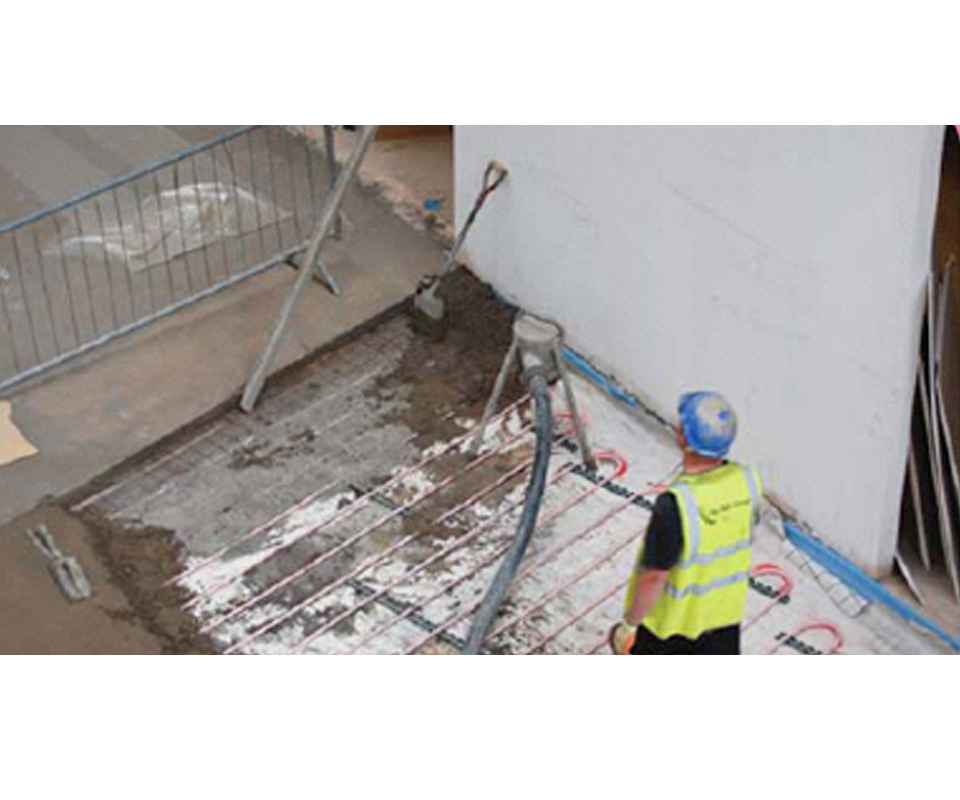Radiant Floor Solutions Specification for Screeds & Concrete
Radiant Floor Solutions Specification for Screeds & Concrete
Standard Cement sand screed mixes
The mix proportions for standard cement and sand screed mixes should be not weaker than the following:
Mix ratio : 1 Part cement: 4 Parts Sand
By volume : 1 Bag cement: 0.13 m³ Sand
By mass : 50 Kg cement: 200 Kg Sand
Sand is defined by BS EN 13139:2002 Table 5 as fine aggregate most of which should pass through a 5.00mm sieve. Grading should not exceed the limits of C & M of this table. The normal term for such material is sharp concreting sand.
The above figures assume dry sand which when damp and un-compacted increases in volume by 20% (6% by weight) and allowance should be made in the above figures when gauging quantities.
Some variations to the above mix ratio may be required for floors with lighter floor finishes such as vinyl and carpet but a mix ratio stronger than 1:3 should not be used.
Fine Concrete Screeds
The mix proportions for a suitable fine concrete for use with floors up to 15 kN should be in line with the following:-
Mix ratio : 1 Part cement
1.5 Parts Fine aggregate
3 Parts Coarse aggregate
By volume : 1 Bag cement
0.08m³ Fine aggregate
0.13 m³ Course aggregate
By mass : 50 Kg Cement
80 Kg Fine aggregate
155 Kg Coarse aggregate

Mixing of Cement sand screeds
Floor screeds should be prepared and laid in accordance with BS 8000: Part 9: 1989 which covers the code of practice on standards of workmanship.
Attention is drawn to the requirement that cement sand screeds should not be too dry since obtaining full compaction will not be possible resulting in a poor floor screed. The normal tilting drum mixer should not be used for semi dry screeds since they produce poorly mixed material with uneven distribution of cement and sand. Mechanical mixers of the trough or pan paddle type are more suited to screed mixes and should always be used in preference. The correct mix can be tested by balling a small quantity in the hand which should retain its shape without excess water being squeezed out.
Additives should be added to clean water in the correct proportion using a water vessel of known volume.
Pre-mixed screed materials are generally both well mixed and consistent in quality and should be used in accordance with the manufacturers’ recommendations.
Laying of Cement sand screeds
Since floating floor screeds are generally thicker than bonded screeds two layers are preferable. The first can be laid bedded around the RADIANT FLOOR SOLUTIONS pipework and covering any reinforcement. This layer should be fully compacted and then raked to immediately receive the second layer which should be brought up to the required final floor level.
Screeds should be laid in large areas with as few joints as possible in one operation. The normal width of bay would be 4.5 metres by any convenient length.
Whilst drying and curing some random cracking will occur but these are easier to deal with than more pronounced cracks created by laying in small bays.
Where there is a change in direction or at door openings and similar points a day joint or trowel cut should be made.
Dependant on the final floor finish the screed can be left with an open texture or closed with a steel trowel finish. Additional surface treatment with smoothing latex may be necessary for certain types of floor finish such as sheet vinyl etc.
Mixing of Fine Concrete
Fine concrete can be readily mixed on site by hand and machine or alternatively delivered as pre-mixed material.
Whether the concrete is site mixed or pre-mixed it should conform to BS EN 206-1. The precise mix requirements will depend on a number of factors such as method of placement and finishing. A higher cement and water content will be required for pumping than for hand placement and the use of smaller aggregates will require adjustments to the mix.
Provided the requirements of the British Standards are complied with a suitable mix can be found to meet the various needs of most floors.
For pre-mixed concrete for floors up to 15kN a suitable standard mix such as ST4 or ST5 modified for use with 10mm aggregate will be found quite suitable for most purposes.
The concrete should only have sufficient water to form a cohesive mix to suit the purpose and excessive water content “bleeding” will affect the quality of the final finish and the time taken.
Laying of Fine Concrete
When laying over insulation the concrete slab will be de-bonded and therefore care needs to be exercised to minimize the risk of curling.
The concrete should be placed in position and worked around all pipes to ensure there are no cavities. The concrete should be brought up to the required level and care exercised to ensure that these levels are maintained.
The area laid should be generally no wider than 4.5 metres with contraction joints positioned where required. The frequency of joints will depend on the acceptability of surface cracking and the overall size of the area. If large areas are to be laid then joints can be formed by the use of crack inducers or by post cutting to a depth equivalent to a quarter of the slab thickness.
The surface should be finished as required by hand trowelling or machine at intervals whilst the concrete is stiffening. This operation will often last several hours with normal evaporation rates however the final finish will depend on the quality and timing of the trowelling operations.
The quality of the final finish required will depend on the final floor covering if any and in some cases a simple tamp finish will suffice.
Alternative Floor and MaterialsThere are many types of floor construction and materials available which are not covered by this specification and if you have any special requirements which have not been covered then we can advise on receipt of the relevant details.
Copyright Radiant © 2026. All rights reserved
